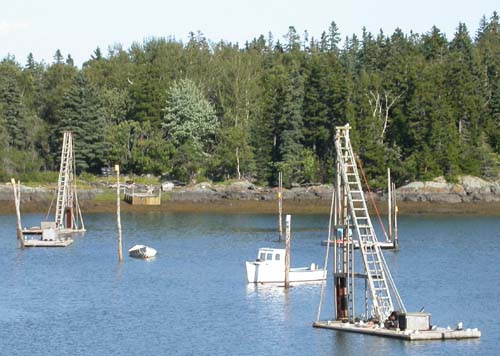Passing through Bangor, Maine, we were surprised and delighted to find our visit coincided with the (free!) National Folk Festival. We weren’t familiar with the festival, but evidently it moves to a new location every three years. Bangor’s a small city, or maybe just a big town, with some real economic problems. The festival didn’t seem any bigger than Seattle’s annual Folklife, but it was a big deal for little Bangor, bringing in much-needed tourist dollars and sparking revitalization of their waterfront.
At first glance, I didn’t see familiar names in the program. Then we sat down in the shade (92 Fahrenheit, so it was the only hot day in Bangor all year), listened to a Grammy-winning Dobro player, and read the program in depth. Henry Butler! I’d heard Henry play the piano live, on the radio in New Orleans, and I knew we were in for a treat. Then I saw that Solas was a band formed by Seamus Eagan — I knew him from his solo album. He was a child prodigy who won the all-Ireland prize in just about every Celtic instrument. A Tejano band called Los Fantasmas del Valle* consisted of three guys in their 60’s who’d been playing together for 40 years, and their new accordionist, at 20, younger than the band itself.
It was a memorable musical day. The Tejano band had us up on the floor dancing, and I could see why they recruited that young pipsqueak for the squeezebox. He was great, and he carried the melodies flawlessly. We were way at the back of the tent for Solas, but I could see which one was Seamus Eagan — he was the fellow who played three different instruments just during the first song. And Henry Butler was just fantastic. He’s totally blind, so he looks a little awkward when he’s sitting on stage and not playing. But once he starts tickling those ivories, it’s like magic. If I wasn’t sitting on the ground, I would have been on the edge of my seat. We gave him a standing ovation, which he couldn’t see, but a number of us (including yours truly) were shouting, “We love you, Henry!” which got his attention.
After the show, we stood in line to get Henry’s autograph. He wrote his full name out, very slowly, with a black marker on the disc itself. I told him of my brother, who’s also blind and named Henry. But he cheats and just writes “Hank” — four letters, all upper case, easy! Henry laughed. I got the feeling he likes taking his time writing his autograph, because he gets to flirt with the ladies. Lucky for me!
*Author’s note: When we get good Internet access, we get a little too excited. I wrote the above entry and published it without checking it over — I accidently sent it out to a bunch of readers without replacing “???” with “Los Fantasmas del Valle!”
**Another author’s note: One reason I love Henry Butler so much is that the following quote is attributed to him: “I decided, after listening to much of the jazz music that was coming out on all the labels, that something wasn’t right. I believe that jazz, generally speaking, is going into a tank … I think I have a chance in my life right now to push the envelope in the blues arena. I was starting not to have as much fun [in jazz}, not because I could not play, but because I was feeling the whole thing was more limiting. I just wanted to have fun and gig.” Right on, Henry. I am sooooooo with you about jazz vs. blues!

